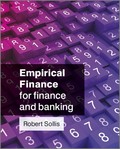Empirical Finance for Finance and Banking

1. Auflage Januar 2012
358 Seiten, Softcover
Wiley & Sons Ltd
Empirical Finance for Finance and Banking provides the
student with a relatively non-technical guide to some of the key
topics in finance where empirical methods play an important
role Written for students taking Master's degrees in
finance and banking, it is also suitable for students and
researchers in other areas, including economics.
The first three introductory chapters outline the structure of the
book and review econometric and statistical techniques, while the
remaining chapters discuss various topics, including: portfolio
theory and asset allocation, asset pricing and factor models,
market efficiency, modelling and forecasting exchange and interest
rates and Value at Risk. Understanding these topics and the methods
covered will be helpful for students interested in working as
analysts and researchers in financial institutions.
Designed for students with limited previous experience of
econometrics, statistics or advanced financial theory, the text is
written in an "easy-to-read" style. It features
empirical examples at the end of each chapter to demonstrate the
empirical methods and theory discussed and uses MATLAB® for
all calculations. A guide to answering end of chapter questions and
relevant computer programs can be found on the companion website:
href="http://www.wiley.com/college/sollis">www.wiley.com/college/sollis
Chapter 1: Introduction
- Subject Matter and Structure
- Computer Software
- Data
- References
Chapter 2: Random Variables and Random Processes
- Introduction
- Random Variables and Random Processes
- Time Series Models
- Summary
- End of Chapter Questions
- References
Chapter 3: Regression and Volatility
- Introduction
- Regression Models
- Modelling and Forecasting Conditional Volatility
- Summary
- End of Chapter Questions
- References
Chapter 4: Portfolio Theory and Asset Allocation
- Introduction
- Returns
- Dividend Discount Model
- Modern Portfolio Theory
- Empirical Examples
- Summary
- End of Chapter Questions
- References
Chapter 5: Asset Pricing Models and Factor Models
- Introduction
- CAPM
- Factor Models
- Empirical Examples
- Summary
- End of Chapter Questions
- Appendix
- References
Chapter 6: Market Efficiency
- Introduction
- Market Efficiency Tests
- Econometric Forecasting
- Technical Analysis
- Data-Snooping
- Empirical Examples
- Summary
- End of Chapter Questions
- Appendix
- References
Chapter 7: Modelling and Forecasting Exchange Rates
- Introduction
- Exchange Rates
- Market Efficiency and Exchange Rate Parity Conditions
- Market Efficiency Tests
- Purchasing Power Parity
- Forecasting Exchange Rates
- Empirical Examples
- Summary
- End of Chapter Questions
- Appendix
- References
Chapter 8: Modelling and Forecasting Interest Rates
- Introduction
- Bonds
- Interest Rate Models
- Empirically Testing the Expectations Hypothesis
- Empirical Examples
- Summary
- End of Chapter Questions
- Appendix
- References
Chapter 9: Market Risk Management
- Introduction
- VaR by the Delta-Normal Approach
- VaR by Historical Simulation
- VaR by Monte Carlo Simulation
- VaR for Bonds
- VaR for Derivatives
- Backtesting
- Financial Regulation and VaR
- Empirical Examples
- Summary
- End of Chapter Questions
- Appendix
- References
Appendix: Statistical Tables


